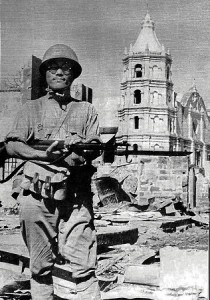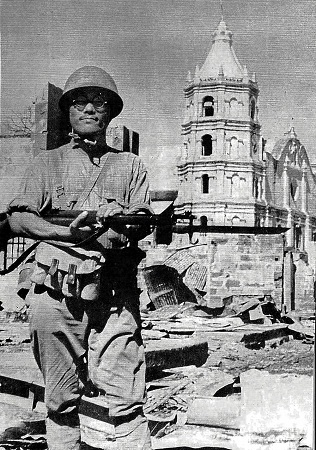 We’re the World War II kids. A unique breed. The war years (1941-1945) brought us face-to-face with terror, violence, death and hunger as a way of life.
We’re the World War II kids. A unique breed. The war years (1941-1945) brought us face-to-face with terror, violence, death and hunger as a way of life.
On Dec. 8, 1941, Japanese fighter planes treacherously bombed Pearl Harbor and Clark Field. I was 5 years old.
December is war nostalgia month. I’ve been leafing through the diary of my late uncle Felix Gozo, and I was transported back to life during the Japanese rule in my hometown, Majayjay, Laguna.
Tio Felix’s wartime diary contained memorable words which captured the look and feel of that horrible Japanese rule. These unforgettable words brought back tragic memories.
Bakwet (Tagalog for “evacuate”)—the panic word that started the exodus. The entire population of Majayjay made bakwet deep into the woods to ramshackle huts, hidden nooks and caves where the Japanese could not find them. Everybody lugged something needed for survival.
I carried a coffee pot in one hand and herded our pet goat with the other. Bakwet was triggered by rumors that the Japanese were coming to massacre people, rape women, and burn houses. They just did in Pagsanjan and Lucban.
Zona (mass incarceration of the male populace)—All men in town were herded and locked up in school buildings and churches. Packed like sardines with no food, no water, no toilet, no sleep, and no talking, they were bullied and beaten in order to extract information about guerilla identities and whereabouts. Lolo Elo, my grandmother’s brother, suffered a heart attack and died inside the zona.
My mother took me to the wake. The next day, only women and children buried Lolo Elo. All the men were in prison.
Horror of horrors
Pinugutan (beheaded)—
The horror of all horrors. Aunt Naty’s husband, Ka Pelis Solisa, the town mayor of Majayjay, was suspected as a guerilla and abducted by the Japanese. It was rumored that Ka Pelis was pinugutan ng ulo somewhere in the forest of Liliw. His body could not be found. Aunt Naty grieved everyday until she died of a heart attack. I saw my mother cry a bucket of tears during Aunt Naty’s funeral. She was my mother’s best friend.
Tinubig (water torture)—A farmer from barrio Pook, another guerilla suspect, was picked up and brought to the municipio, and made to lie on his back stripped naked. His captors forced water through his mouth until his stomach was full and bloated, then they pummeled his stomach with a palo-palo until he vomited water. The water torture is repeated many times until the victim passes out.
Kinulata (beaten with a rifle butt)—After a truckload of them were ambushed by the guerillas, the Japanese rounded off all the men in our neighborhood and kinulata sila. They were beaten with rifle butts hard on the chests, waists, butts and legs, leaving them maimed and crippled for several months.
Binilad (sunburnt and dehydrated)—For failure to bow before Japanese sentries, failure to understand garbled Japanese orders, the offender was forced to stand motionless under the hot sun for hours until he collapsed due to heatstroke or dehydration.
Pinagsasampal (slapped repeatedly on the face)—When a Japanese guard accosted or interrogated a person, he talked fast, harsh and boorish, punctuating his blabbermouth tirades with slaps on the face. Expletives and curses were spoken in Nippongo. For forgetting to bow before a Japanese sentry, our neighbor, Mang Leocadio, was pinagsasampal. Was his face red! Bloody red!
Buslo (mystery man)—This bizarre creation of the Japanese was a Filipino traitor who appeared on the scene with his head fully covered by a buslo (a pandan-woven shopping bag) with two holes to serve as his eyes. When the Japanese assembled the men in town, Buslo would point a finger at the guerilla on the lineup, true or not.
Makapili (collaborator)—
This shadowy individual was a Filipino who rendered service to the Japanese government. He acted as the mouthpiece for Japanese policies, persuading people to cooperate with Japanese efforts in managing political affairs and governance. After the war, the Makapilis were tried by the Philippine government for treason.
Forgive
It’s been 70 years since then. Have we forgiven the brutal and masochistic Japanese regime? The destruction and mayhem they’ve caused? Can we, World War II kids, forgive? We did. It must be our Christian culture, plus a lot of help from the power of consumerism.
By the ’60s, we had welcomed the return of the Japanese, wittingly or unwittingly. We bought Sony transistor radios, Akai tape recorders, Casio calculators, National electric fans and refrigerators. In the ’70s, my first car was a Toyota Crown sedan. My teenage daughters went crazy over Sanrio characters.
In 2002, our family toured Japan. We marveled at Japanese art, costumes, cuisine and the colorful festivals. Japanese politeness and social graces are admirable. Their cleanliness, superb. My current vehicle is a Toyota Fortuner. I’m wearing a Seiko watch.
But we have not forgotten the sufferings. In fact, some anger still lingers in the hearts of Filipino comfort women. Now in their 90s, comfort women were young, innocent girls in the early 1940s who were forcibly taken by the Japanese army to be used as their sex slaves (20 to 30 soldiers raped them daily.) They surfaced in 1993 to seek justice and retribution from the Japanese government.
Us World War II kids are aging and dwindling fast. In a few years we’ll all be gone. Will our children and grandchildren ever remember our tragic past? Methinks not. They are creatures of Steve Jobs, wired and immersed in data overload, knowledge clutter, and a short attention span. World War II’s tumult was destined only for us. We alone can mull the details, relish the dangers and adventures.
We World War II kids are a unique breed. We are not afraid of the unknown.
E-mail [email protected].













































